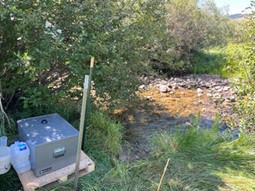 From USGS (United States Geological Survey) – Imagine you could use just a few drops of water to know what sorts of animals and plants were present in an area. What an incredible tool this would be. It could be used to look for rare species, to catalogue how many were present or to monitor for introductions of new, potentially harmful species. Turns out, we already have this tool. Using a small sample of water, scientists can look for genetic material left behind by anything with a genome—a species’ genetic fingerprint made from DNA—which scientists call environmental DNA, or eDNA. Aquatic biodiversity, or the number of species in freshwater and marine systems, is important culturally and economically as well as to the health of society and ecosystems. Using such a powerful, nondestructive tool as eDNA sampling gives scientists and people managing water, land and municipalities the ability to evaluate and predict trends in biodiversity at the scale they need, from a single pond to a river system and even the oceans. (more)
From USGS (United States Geological Survey) – Imagine you could use just a few drops of water to know what sorts of animals and plants were present in an area. What an incredible tool this would be. It could be used to look for rare species, to catalogue how many were present or to monitor for introductions of new, potentially harmful species. Turns out, we already have this tool. Using a small sample of water, scientists can look for genetic material left behind by anything with a genome—a species’ genetic fingerprint made from DNA—which scientists call environmental DNA, or eDNA. Aquatic biodiversity, or the number of species in freshwater and marine systems, is important culturally and economically as well as to the health of society and ecosystems. Using such a powerful, nondestructive tool as eDNA sampling gives scientists and people managing water, land and municipalities the ability to evaluate and predict trends in biodiversity at the scale they need, from a single pond to a river system and even the oceans. (more)
-
- Translation Notice

